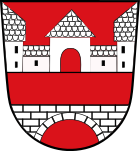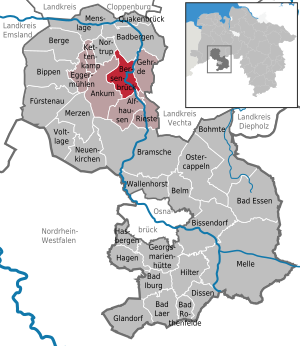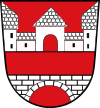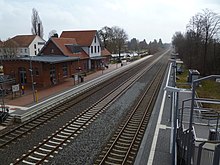Bersenbrück
| coat of arms | Germany map | |
|---|---|---|

|
Coordinates: 52 ° 33 ' N , 7 ° 57' E |
|
| Basic data | ||
| State : | Lower Saxony | |
| County : | Osnabrück | |
| Joint municipality : | Bersenbrück | |
| Height : | 35 m above sea level NHN | |
| Area : | 42.54 km 2 | |
| Residents: | 8618 (Dec. 31, 2019) | |
| Population density : | 203 inhabitants per km 2 | |
| Postal code : | 49593 | |
| Area code : | 05439 | |
| License plate : | OS , BSB, MEL, WTL | |
| Community key : | 03 4 59 010 | |
| LOCODE : | DE BBK | |
| City structure: | 7 districts | |
City administration address : |
Lindenstrasse 2 49593 Bersenbrück |
|
| Website : | ||
| Mayor : | Christian Klütsch ( CDU ) | |
| Location of the city of Bersenbrück in the Osnabrück district | ||
Bersenbrück ( Low German Bessenbrügge ) is a town on the river Hase and the administrative seat of the joint municipality of Bersenbrück in the Osnabrück district in Lower Saxony .
geography
location
Bersenbrück is located between the Ankumer Höhe and the Dammer Mountains on the Hase .
City structure
- Ahausen-Sitter
- Bokel
- Hastrup
- Hertmann-Lohbeck
- Priggenhagen
- Tallow
- Woltrup-Wehbergen
Neighboring communities
|
Nortrup 9 km |
Badbergen 10 km |
|
|
Ankum 6 km |

|
Gehrde 5 km |
|
Alfhausen 7 km |
Rieste 11 km |
climate
Temperate maritime climate influenced by humid northwest winds from the North Sea. On a long-term average, the air temperature in Bersenbrück reaches 8.5 to 9 ° C and about 700 mm of precipitation falls. Between May and August, an average of 20 to 25 summer days (climatological term for days on which the maximum temperature exceeds 25 ° C) can be expected.
history
The first written mention of the place ( Bersinbrugge ) is dated to the year 1221, but the settlement is probably much older, as the surrounding villages were already mentioned around the year 1000. Otto von Ravensberg in 1231 founded a Cistercian - Kloster due to "an in feuds with Tecklenburg committed at this point outrage" (monument inscription). Presumably, however, political reasons for founding the monastery were decisive. The Cistercian monastery existed from 1231 to 1787. The task of the monastery was also able to create the present-day town of Bersenbrück. Because of the seclusion of the monasteries required by the order, the farmers settled at a distance of several hundred meters from the monastery. Now the first houses were built in front of the monastery gate, and the empty monastery buildings were increasingly used for administration and jurisdiction.
Many of the families still living in the village are mentioned in official documents as early as the 15th century.
From 1885 to 1972 Bersenbrück was the administrative seat of the district of the same name , which was dissolved as part of the regional and administrative reform on July 1, 1972 and combined with the districts of Wittlage , Melle and Osnabrück to form the district of Osnabrück .
Bersenbrück has been a town since 1956 . The joint community of Bersenbrück was founded in 1972 and consists of the member communities Alfhausen , Ankum , Bersenbrück, Eggermühlen , Gehrde , Kettenkamp and Rieste .
Place name
Former place names of Bersenbrück were in the years 1221 Bersinbrugge, 1231 Bersembrugge, 1301 Bersenbrucge and 1723 Berßenbrück. The place name is an education with the basic word "-brück". The term contains a water body name "Bersina / Birsina", which in turn is a derivative with the "-n-" suffix. Derivation basis is “better” for “fast”. Later the name "Hase" - as in Osnabrück, actually "Bridge over the Osna" - caught on.
Incorporations
As part of the regional reform in Lower Saxony , the previously independent communities Ahausen-Sitter and Talge were incorporated into the city of Bersenbrück on July 1, 1972.
Population development
|
|
¹ census results of June 6th (including the places which were incorporated on July 1, 1972)
² results of the census of May 27 (including the places which were incorporated on July 1, 1972)
³ as of December 31st
religion
Bersenbrück's population is predominantly Roman Catholic . The settlement of repatriates from the former Soviet Union has increased the proportion of Protestant believers. The Catholics are still the largest Christian community in Bersenbrück.
There is a Roman Catholic, an Evangelical and a Baptist church community.
politics
City council
The city council currently has 23 members from three parties and an electoral community. With 13 seats, the CDU holds the absolute majority of the mandates and provides the mayor.
The following table shows the local election results since 1996.
| Council of the city of Bersenbrück: election results and city councils | |||||||||||||||||||
|---|---|---|---|---|---|---|---|---|---|---|---|---|---|---|---|---|---|---|---|
| CDU | SPD | UWG | GREEN | total | electoral participation |
||||||||||||||
| Electoral term | % |
|
% |
|
% |
|
% |
|
% |
|
% | ||||||||
| 1996-2001 | 66.1 | 14th | 27.6 | 6th | - | 6.3 | 1 | 100 | 21st | 69.9 | |||||||||
| 2001-2006 | 69.7 | 15th | 26.0 | 6th | - | 4.2 | - | 100 | 21st | 64.2 | |||||||||
| 2006-2011 | 64.2 | 14th | 29.1 | 6th | - | 6.7 | 1 | 100 | 21st | 48.8 | |||||||||
| 2011-2016 | 56.7 | 12 | 23.2 | 5 | - | 20.1 | 4th | 100 | 21st | 50.3 | |||||||||
| 2016-2021 | 56.3 | 13 | 20.6 | 5 | 12.2 | 3 | 10.9 | 2 | 100 | 23 | |||||||||
|
Percentages rounded. Sources: State Office for Statistics and Communication Technology Lower Saxony, District Osnabrück. In the case of different information in the sources mentioned, the data from the State Office for Statistics and Communication Technology were used, as they are generally more plausible. |
|||||||||||||||||||
mayor
Christian Klütsch (CDU) has been the city's mayor since 2013 . His deputies are Franz Buitmann (CDU) and Johannes Koop (CDU).
Chronicle of the mayor
- 2013 – date: Christian Klütsch (CDU)
- 2005–2013: Harald Kräuter (CDU)
- 2001-2004: Renate Hülsmann (CDU)
- 1981-2001: Walter Sandbrink (CDU)
coat of arms
| Blazon : "In the divided red shield above the stylized silver gate of the city monastery, below a silver stone bridge ." | |
| Justification for the coat of arms: The upper silver cloister gate of the St. Marien Monastery indicates the landmark of the city of Bersenbrück. It was built in 1700 by the abbess of Nyvenheim. The lower silver bridge symbol has been added in connection with the place name ( talking coat of arms ). |
Town twinning
- Bersenbrück has had a town partnership with the French town of Tinténiac in the canton of the same name ( Brittany region ) since 2000 . It emerged from a student exchange that took place for the first time in 1998 between the Bersenbrücker Gymnasium and the Collége Théophile Briant in Tinténiac.
- Another partnership was also agreed in 2000 with the Polish city of Gryfino (Greifenhagen) on the Oder .
Culture and sights
Museums
The “Museum in the Monastery” of the district of Osnabrück, which was founded in 1924 by District Administrator Hermann Rothert as a district museum, is located in the historic Remter in the Stiftshof .
The exhibition consists mainly of historical pieces and shows the life of the simple rural population. Contemporary works of art are also regularly exhibited.
The “Krabat” cultural center is located on the Hasemühle. It was opened in 2000 and founded by a non-profit association that was the successor to the art-land art association, after the mill first hosted an art exhibition in 1997. Affiliated to the association is an art and creative school, which has its own studio with an outdoor area.
Buildings
The landmark of Bersenbrück is the monastery gate with gatehouse ("port house") of the former Cistercian monastery , which is located directly on the market square, built by the abbess Nyvenheim in 1700 . After the monastery was dissolved in 1787, a living area for the porter and night watchman remained in the north wing of the port house . When the Bersenbrück Office was founded in 1817, the prison was housed on the first floor. The south wing, in which apartments were later also built, served for a long time as a church warehouse and tavern . The magnificent baroque coat of arms of those of "Nyvenheim-Boetzelaer" above the archway of the gate is the only surviving coat of arms from the monastery period. The inscription reads: "Glory to God, the order as ornament, for the sake of posterity, Maria Catharina von Nyvenheim, abbess in Bersenbrück, anno 1700, October 14th, had this gate built."
The Roman Catholic parish church of St. Vincentius , located on the former monastery grounds, dates from the 12th century and was built in the transition period between Romanesque and Gothic. The former monastery, donated by Otto II von Ravensberg in 1231, is located in the immediate vicinity, today the district court and the "Museum in the Monastery", which was redesigned in 2018 , are located in the rooms . This museum was founded in 1924 by the then district administrator of the Bersenbrück district, Hermann Rothert . The Franz Hecker Hall in the town hall is one of the cultural sights, as is the harvest room. There is a "night watchman tour" to the sights.
Art in public space
In the south of Hare island about 100 km long, in starts Meppen ending Hare Taler Art Route . The first work of art in this route is the 2005 erected sculpture of sandstone throne of the King of carp and his queen Mandir E. Tix. The artist belongs to a group of sculptors who work for the “Krabat” cultural center near the Hasemühle. Four from this group made the wooden sculpture with the programmatic name “Decay” in 2006. Over the years, viewers can observe how the sculpture, which was not treated with wood preservatives, visibly deteriorates.
City forest
Immediately behind the monastery complex, the hare is artificially divided at a flood barrier . The city forest Hemke that of the rabbit and the hare channel ( mill Hase is enclosed) has, over a fishing trail . In the north of Bersenbrück there is a forest area, the northern part of which was formerly the monastery fish pond, still recognizable by ditches and ramparts. Abbess Hedwig Catharina von Hane had a fallow land lying south of it afforested during her tenure from 1755–1781. It was soon called Hedwig's Joy or Hedwig's Pleasure. Today the whole area is called Stadtwald Freude .
Regular events
- Since 1994, one of the largest reggae festivals in Germany has been held annually in July / August in the Bersenbrück monastery garden . The reggae jam has become an integral part of the Bersenbrück annual schedule.
- Every summer a two-day festival with an international small-field soccer tournament takes place in the Talge district. The Talge Open Air is organized annually on the second weekend in July by FC Talge.
- Every two years, the “Potato Market” (the Bersenbrück city festival ) alternates with an automobile exhibition in autumn . Local producers offer their products there, the range of many clubs and groups as well as the showmen round off the market.
- The spring fair takes place on the second Sunday in May.
Economy and Infrastructure
Companies
There are a large number of small and medium-sized companies in Bersenbrück, some of which are also known nationwide.
- Kalle GmbH (formerly Kalle Nalo GmbH): Manufacturer of sausage casings (artificial casings) and sponge cloths, headquarters in Wiesbaden
- Lear Corporation (formerly Grote-Hartmann GHW): Manufacturer in the automotive supply industry
- Wurst Stahlbau GmbH: The company produces steel structures for steel halls, parking garages, car dealerships and the like. In 2007, the steel construction for the new Neumayer III polar research station was manufactured, which made the company known nationwide. In 2011, the company was awarded the ntv medium-sized enterprise award " Hidden Champion 2011" for its performance as an economically successful and socially committed company.
Public facilities
Bersenbrück is the seat of the Bersenbrück District Court . The municipal administration is housed in the town hall. The city administration has moved into its own premises separately on the market. Furthermore, at public facilities in the city u. a. the health department , veterinary office , the district road maintenance department , the fire department technical center for the northern part of the district of Osnabrück and the employment agency as the office of the Federal Employment Agency .
education
There are five kindergartens in Bersenbrück, one of which is a speech therapy kindergarten and an integration kindergarten. A primary school, a high school, a grammar school and the vocational school in the district of Osnabrück are available for pupils of all age groups.
The district music school is also located in Bersenbrück. There is also a wide range of educational and care options for disabled people, e.g. B. the association “Heilpädagogische Hilfe” with the “ Paul-Moor- Bildungsinstitut”, a day-care center that has been able to call itself “Paul-Moor-Schule”, named after the pedagogue Paul Moor , since the summer of 2007 .
The Volkshochschule Osnabrücker Land regularly organizes courses on various topics (mainly adult education ).
The media forum, which is a connecting building between the two schools, emerged from a cooperation between the district of Osnabrück (as school authority), the joint municipality of Bersenbrück, the vocational school and the grammar school. The library, computer rooms and seminar rooms are not only used for schools, but are also available to the public.
traffic
Bersenbrück is on the federal highways B 214 and B 68 . The nearby A 1 motorway can be reached via the Holdorf and Neuenkirchen-Vörden junctions. In December 2004 the new bypass road for the B 68 was opened, which noticeably relieved the city center . By Bersenbrueck which runs tourist route Artland route .
The Bersenbrück station on the Oldenburg – Osnabrück railway line is served hourly by the RE 18 (Wilhelmshaven - Osnabrück) and is thus connected to the national rail network of Deutsche Bahn . The rail traffic is operated by the NordWestBahn . The Bersenbrück – Ankum railway branches off from this connection . Only freight trains have been running on it since 1962; tourist use began in 2018.
Others
- The vehicle registration number of the former Bersenbrück district , "BSB", is very common in Bersenbrück and the surrounding area as an abbreviation for Bersenbrück and is often used.
Personalities
sons and daughters of the town
- Carl Anton Lüpke (1775–1855), auxiliary bishop in Osnabrück and titular bishop of Anthedon
- Arnold Buddenberg (1811-1892), politician of the National Liberal Party
- Franz Hecker (1870–1944), painter
- Oskar Hecker (1864–1938), geophysicist
- Kurt Delkeskamp (1902–1988), librarian and entomologist
- Peter Fischer-Hollweg (* 1939), retired political scientist in the diplomatic service of the Federal Foreign Office and is now an honorary ambassador of the Sovereign Order of Malta in Latvia
- Hans-Gert Pöttering (* 1945), CDU politician and former President of the European Parliament
- Paul Wessler (* 1949), master student with K.-H. Herrfurth, numerous art exhibitions
- Hermann Winner (* 1955), physicist
People connected to the city
- Gustav Nietfeld-Beckmann (1896–1961), politician ( NSDAP ), died in Bersenbrück
literature
- Werner Dobelmann : The book from the district of Bersenbrück. A local history for school and home. Quakenbrück 1953.
- Werner Dobelmann: Origin and development of the place Bersenbrück. In: Franz Buitmann, Werner Dobelmann, Franz Hülsmann, Ernst Schulte (Red.): Bersenbrück. City in the Osnabrück region. Contributions to the anniversary year 1981 in words and pictures. 750 years of Bersenbrück - 25 years of the city. Bersenbrück 1981, pp. 27 [26] -84.
Web links
- Internet presence of the city of Bersenbrück
- Internet presence of the joint municipality of Bersenbrück
- Search for "Bersenbrück" in the German Digital Library
- Search for Bersenbrück in the SPK digital portal of the Prussian Cultural Heritage Foundation
Individual evidence
- ↑ State Office for Statistics Lower Saxony, LSN-Online regional database, Table 12411: Update of the population, as of December 31, 2019 ( help ).
- ^ Jürgen Udolph (research): The "place name researcher". In: Website NDR 1 Lower Saxony . Archived from the original on August 17, 2014 ; accessed on August 3, 2019 .
- ↑ a b c Federal Statistical Office (ed.): Historical municipality directory for the Federal Republic of Germany. Name, border and key number changes in municipalities, counties and administrative districts from May 27, 1970 to December 31, 1982 . W. Kohlhammer, Stuttgart / Mainz 1983, ISBN 3-17-003263-1 , p. 253 .
- ↑ a b c d Michael Rademacher: German administrative history from the unification of the empire in 1871 to the reunification in 1990. District of Bersenbrück ( see under: No. 12 ). (Online material for the dissertation, Osnabrück 2006).
- ↑ Ulrich Schubert: Community directory Germany 1900 - Bersenbrück district. Information from December 1, 1910. In: gemeindeververzeichnis.de. January 5, 2020, accessed June 22, 2020 .
- ↑ a b Statistisches Bundesamt Wiesbaden (ed.): Official municipality register for the Federal Republic of Germany - 1957 edition (population and territorial status September 25, 1956, for Saarland December 31, 1956) . W. Kohlhammer, Stuttgart 1958, p. 194 ( digitized version ).
- ↑ Lower Saxony State Administration Office (ed.): Municipal directory for Lower Saxony . Municipalities and municipality-free areas. Self-published, Hanover January 1, 1973, p. 52 , district of Osnabrück ( digitized version ( memento from 7 August 2019 in the Internet Archive ) [PDF; 21.3 MB ; accessed on June 22, 2020]).
- ↑ a b c d e f g h i j community directory - archive - regional structure - annual editions - Lower Saxony. (All politically independent municipalities in EXCEL format). In: Destatis website. Federal Statistical Office, accessed on January 4, 2020 .
- ↑ a b Mayor and Council. In: Website City of Bersenbrück. Retrieved January 4, 2020 .
- ↑ Table 5000311. In: Website of the State Office for Statistics and Communication Technology Lower Saxony. Retrieved January 4, 2020 .
- ^ Official final results of the district election 2001. (PDF; 528 kB) In: Website Landkreis Osnabrück. September 9, 2001, p. 33 , archived from the original on May 25, 2005 ; accessed on January 4, 2020 .
- ^ The local elections for the district of Osnabrück 2011 (also includes 2006 results). (PDF; 8 MB) In: Website of the district of Osnabrück. September 11, 2011, p. 31 , accessed on January 4, 2020 (column “Municipal elections ”).
- ↑ Martin Schmitz: The "little mayor". Bersenbrück: Farewell to Harald Kräuter. In: Website Neue Osnabrücker Zeitung . September 25, 2013, accessed January 4, 2020 .
- ^ BSB: Manfred Krusche new SPD parliamentary group leader. In: Website plain text. February 2, 2018, accessed January 4, 2020 .
- ↑ Applause for Walter Sandbrink. In: Website Neue Osnabrücker Zeitung. July 2, 2006, accessed January 4, 2020 .
- ↑ The coat of arms. In: Website City of Bersenbrück. Retrieved January 4, 2020 .
- ^ Talge Open Air. In: talge-open-air.de. Retrieved January 4, 2020 .
- ↑ FC Talge 72 e. V. In: fc-talge.de. Retrieved January 4, 2020 .












